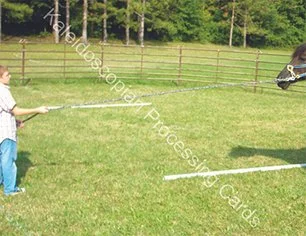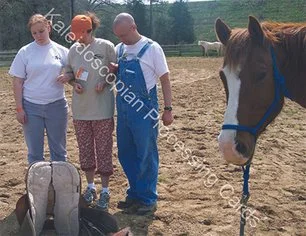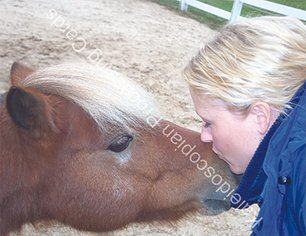DISCONNECT
A local social services agency worked with us to provide a three-prong program; we designed two half-day staff trainings at my farm, which sandwiched a program at their facility for the youth they served. The agency’s mission was to provide safety, sustenance, nurturing and therapeutic interventions to children. Their services focused on adolescents suffering from the social injustices of abuse and neglect.
Their students/inmates lived in a 24/7 locked down, gated, guarded facility. Many of the residents had substance abuse and addiction challenges requiring staff with specializations, certifications, and therapeutic backgrounds.
When we met with the principal of the school who hired us to provide this in-service training, we discussed at length the importance of her staff investing in themselves and their relationships with one another. She was clear that one of our key objectives should be for the adults to have their own equine-assisted learning (EAL) experience as a group of co-workers. She recognized the passion her team had for the kids and their well-being, often at the detriment of their own interests.
We began our first staff training with a pre-assessment of: “describe your perfect day, your worst day, what you expect from your equine experience, and the closing question of sharing something others likely do not know about you.”
The perfect day was what anyone would desire, everyone getting along, honest, open and effective communication, and no problems.
The worst day was also pretty predictable, lack of trust/respect/caring, manipulation, deceit, poor communication and boring meetings.
When only 13 of the 20 participants responded to our last question, this told us that some were uncomfortable sharing with each other, offering a clue to their unhealthy organizational culture. Their lack of personal investment and willingness to be vulnerable highlighted what the principal sought to overcome, that they were not really interested in their own self-improvement as a team, rather, their main focus was on the kids. She also guided us to make sure our program design supported these educators in transferring their learning from a “wish” to an action, with accountability to themselves and the group. Little did we realize how obvious it would be in our second staff training that they were primarily interested in the students. We learned they thought it was much easier (emotionally safer?) to look externally instead of the hard work of personal growth/change.
The training included several equine-assisted learning activities, sequenced to support them in creating SMART goals, which we planned to revisit in our second in-service training. SMART is an acronym for setting goals that are Specific, Measurable, Achievable, Relevant, and Time-bound. This framework helps create clear, actionable objectives by defining what needs to be done, how to track progress, ensuring the goal is within reach, aligning it with larger objectives, and setting a deadline for completion.
We provided a two-day equine-assisted learning experience for the residents at their facility. In addition to the educational staff that were participating in these two in-service trainings, the residential staff was also exposed to the power of partnering with horses for personal growth and development.
Part three of the training was inviting the educators back out to Kaleidoscope for a final half-day. We invited them to provide us with feedback on their work toward their SMART goals via a survey. Only six people, out of the twenty participants completed our survey. Finding that lack of investment very frustrating, I created the following to kick off our meeting:
Once upon a time there was a flock of very, very valuable (and wonderful) chickens. Now, these were no ordinary chickens, because these chickens worked with the farmer to meet his egg quotas and objectives.
One way that the chickens learned how to produce enough eggs of the right size was by working together to achieve the larger goal. Working together was not always an easy task - sometimes the chickens would feel judged, wondering why they should even try and then would shut down and not lay eggs. On these days even if they laid an egg, it was not one of their best eggs.
On the days that all of the chickens worked together, listened to each other, asked questions when they were unsure of the exact quota, and basically got along, those where the days that made the chickens happy, the farmer happy, and even the farmer’s wife happy (the farmer’s wife didn’t really like chickens at all, so to make HER happy took some doing).
One day near Easter the farmer came to the chickens and told them he had a special quota request – he asked that each chicken lay an egg that was exactly 3 inches tall and 2 inches wide for the next week. There eggs were going to be used by the Easter bunny, and he was a fussy bunny! Not a chicken asked a question or even squawked.
The next day, the farmer was somewhat surprised to find only six chickens had even tried to lay their eggs. He guessed that maybe the chickens didn’t believe in the Easter bunny, but he wasn’t sure. He scratched his head and wondered what to do . . . he needed the chickens to continue to work together and life was so much better for everyone when each chicken made a commitment to work for the betterment of the whole group.
Seeing themselves in the chicken story, we were able to transparently move into the rest of the training with them fully present. Interestingly, the evaluations told us that one of their favorite experiences was the closing activity, making connections by tossing a ball of yarn.
We invited the group to become one big circle. Then, I took a ball of yarn, tossing it to Stacie. I shared that Stacie and I had a connection because we both loved being equine-assisted facilitators. She held her end, then tossed the yarn to one of the participants. She shared that she had a connection to Dan because they had worked together at a different group home years ago. Dan then tossed it to one of his co-workers, explaining that their connection was that they both lived in the same town. On and on this went until every person what holding a piece of the yarn ball, the space between the people appearing to be a spider’s web with the multi-colored yarn crisscrossing each other back and forth.
I then produced a pair of scissors from my back pocket, simulating cutting the yarn. You could hear an audible gasp from several of the participants. We explained that often we share these invisible ties with each other, sometimes without even realizing it. The desire to shed light on those connections takes curiosity, engagement, and commitment. Several of the participants took us up on the offer to take a small piece of yarn with them, “as a symbol of connection and co-operation.”
This simple activity of tossing a ball of yarn held so much emotional power because of the magical combination of the transparency we established through our chicken story, as well as the honest, genuine, and sincere feedback horses always provide. We moved not only the yarn, we moved the people, from a clear disconnect to a connection that held meaning beyond their shared love for the kids they served.
Recall a situation where there is a clear disconnect between you and your host. What are the circumstances that led to this mismatch?
What actions have you taken in future experiences to more carefully align your goals with that of your companions?
What advise would you give your future self to further connect you to those persons, places, and things around you?







